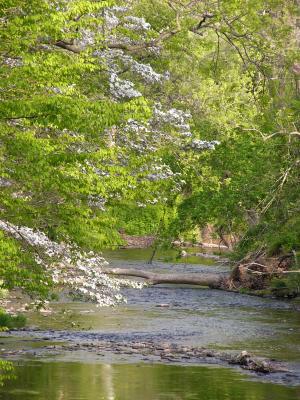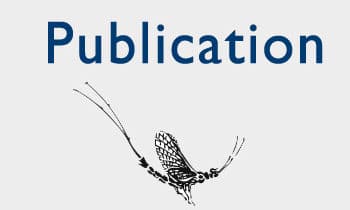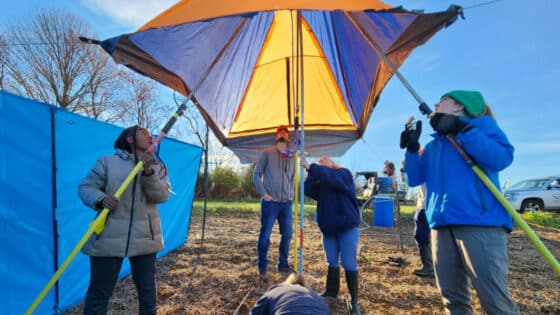
Stroud Water Research Center and its 800 ha, 3rd-order drainage basin was designated an Experimental Ecological Reserve in 1981 by the National Science Foundation (NSF). This designation, based upon the criteria of site quality, research activities, logistics and financial support, recognized that this field research facility was dedicated to long-term experimental research on an ecosystem and is an outstanding representative of its type.
The east branch of White Clay Creek is classified by the Commonwealth of Pennsylvania as an Exceptional Value stream and watershed. This is the highest classification given and affords the watershed special protection against environmental disturbance of anthropogenic origin.
In 1998, the White Clay Creek experimental watershed, extending from the Stroud Water Research Center north to the headwaters, was designated as a site for long-term research in environmental biology (LTREB). The NSF LTREB grant to Stroud Center scientists recognizes that many important questions in ecology require the acquisition of long time series of data. NSF funds are being used to help maintain an on-going long-term research project examining stream and watershed characteristics associated with a riparian zone restoration/reforestation.
In this LTREB project, the overarching goals involve discerning the time period required for recovery and the most salient features and final condition of a recovered state. LTREB funding is being used to: (1) maintain existing watershed installations to continue an on-going acquisition of long-term data on White Clay Creek, (2) address the data management needs of the long-term project, including making the data available to the research community, and (3) testing hypotheses concerning long-term variations in stream ecosystem structure and function under stable and/or recovering conditions.
Project Site
The White Clay Creek watershed, like most of the Eastern North American landscape, experienced dramatic anthropogenic disturbances over a relatively short time period (300 years). These are characterized by deforestation for lumber, charcoal, and agriculture, and more recently the broad scale creation of impervious surfaces, introduction of pesticides, increased use of fertilizers, and atmospheric deposition of nitrogen from the combustion of fossil fuels. These landscape and landuse changes have generated conditions that stress stream ecosystems, however, little is known about how streams in the Piedmont physiographic province have responded to these stresses. Even less is known about how streams respond as the disturbed landscapes recover.
When Stroud Water Research Center was established in 1967, the agriculturally dominated watershed contained an upstream riparian forest of 60 to 100 year old trees and downstream meadows subject to cattle grazing. Initially, several long-term sampling reaches on the White Clay Creek were selected, including woodland and meadow reaches. When cattle were removed from the meadow reach adjacent to the laboratory, the riparian zone became colonized by multiflora rose (Rosa multiflora (Thunb)). Over a 23-year period the multiflora rose grew to border the stream in a swath that was 3 meters tall and 5 meters wide. In 1989, the Center began a riparian zone restoration and reforestation project with the goal of reestablishing a contiguous deciduous forest extending through the meadow reach upstream to headwater spring seeps 3 km away. Multiflora rose plants were uprooted and tree seedlings of native species were planted. Between 1988 and 1994, five lateral transects from the uplands to the stream were instrumented with wells, lysimeters, and in-stream piezometers. In 1997, the reforestation project was extended into a meadow downstream of the laboratory.
Data
The tables below list our long-term datasets for White Clay Creek, a subset of which are available for download on HydroShare. If you have trouble accessing the data, please email webmaster@stroudcenter.org.
Physical Data
Discharge is presented as daily maximum and precipitation as daily total.
| Parameter | Site | Period of Record | Frequency |
|---|---|---|---|
| Discharge | Watershed boundary | 1969-present | Continuous |
| Temperature | Meadow, woodland, & springs | 1969-present | Continuous |
| Channel Geomorphology | Woodland, meadow, tributaries | 1972-present | Periodic |
| Solar Radiation | Meadow | 1969-present | Continuous |
| Precipitation | Meadow | 1969-present | Continuous |
Chemistry Data
Water chemistry is presented as the concentration based on a periodic grab sample.
| Parameter | Site | Period of Record | Frequency |
|---|---|---|---|
| Nutrients: NO3, NO2, NH3, PO4 | Woodland | 1969-present | Weekly 1969-1995;monthly 1996 present |
| Meadow | 1996-present | Storms once/season | |
| Springs & tributaries | 1969-1989 | Once to several times annually | |
| Wells & lysimeters | 1994-1997 | Every other month, 1994-1997; 1998-present periodic | |
| Nutrients: TKN, TP | Woodland | 1996-present | Monthly |
| Cations: Ca, K, Mg, a, Zn, Cu, Mn, Fe | Woodland | 1969-present | Weekly 1969-1995; monthly 1996-present |
| Meadow | 1996-present | Storms once/season | |
| Anions: SO4, Cl | Woodland | 1969-present | Weekly 1969-1995; monthly 1996-present |
| Meadow | 1996-present | Storms once/season | |
| pH, alkalinity | Woodland | 1969-present | Weekly 1969-1995; monthly 1996-present |
| Conductivity | Meadow | 1994-present | Daily & each storm |
| Wells & lysimeters | 1994-1997 98-present | Every other month Periodic | |
| Dissolved Organic Carbon | Meadow | 1972-1975 | Weekly to monthly & seasonal storms |
| 1978-1994 | Daily to weekly & seasonal storms | ||
| 1995-present | Daily & all storms | ||
| Wells & lysimeters | 1988-1997 1998-present | Weekly to every other month Periodic | |
| Tributaries & springs | 1978-present | Periodic | |
| Classes of Organic Compounds (lipids, carbohydrates, phenolics, amino acids) | Meadow, tributaries & springs | 1972-present | Periodic |
| Amino acid molecules | Meadow | 1993-present | Seasonal storms |
| Carbohydrate molecules | Meadow, wells, lysimeters, & springs | 1994-1996
1997-present | Weekly & seasonal storms
Periodic |
| Humic substances | Meadow, wells, lysimeters | 1993-1997 | Monthly |
| Humic-Bound Lignin Phenols | Meadow, woodland, wells, & lysimeters | 1993-1997 | Periodic |
| Biodegradable DOC | Meadow | 1992-present | Weekly |
| Wells & lysimeters | 1994-present | Periodic | |
| Pesticides | Meadow, woodland & tributaries | 1993-1997 | Periodic |
| Seston | Woodland | 1993-present | Weekly |
| Meadow | 1995-present | All storms |
Biological Data
| Parameter | Site | Period of Record | Frequency |
|---|---|---|---|
| Suspended chlorophyll | Woodland | 2001-2004 2005-present | Monthly Weekly |
| Benthic Organic Matter | Woodland | 1976, 1997 | Seasonal |
| Meadow | 1997 | Seasonal | |
| Tributaries | 1991 | Seasonal | |
| Leaf Litter Inputs | Woodland | 1973-1974 | Weekly |
| Woodland & meadow | 1991-2000 2005-present | Weekly to monthly Weekly to monthly | |
| Woody Debris | Woodland & meadow | 1991 | Late Autumn |
| Algal Biomass | Woodland & meadow | 1973-1975 1976 1997-2006 | Daily to weekly Seasonally Seasonally |
| Community Metabolism (GPP, Respiration, Net Daily Metabolism) | Woodland & meadow | 1971-1975 1976 1997-2006 | Daily to weekly Seasonally Seasonally |
| Algal Community Composition | Woodland | 1969-1971 | Weekly to monthly |
| Bacterial Productivity | Meadow | 1980-81; | Seasonally |
| 1985-86; 1989 | Seasonally | ||
| Bacterial Densities | Meadow | 1980-81; 1985-86; 1989; 1999-present | Seasonally |
| Bacterial Community Composition | Woodland & meadow | 1999-present | Periodic |
| Protozoan Community Composition | Woodland | 1969-1970 | Weekly to monthly |
| Protozoan Densities | Meadow & tributary | 1983-1985 | Monthly |
| Protozoan Bacterivory | Meadow | 1984-1985 | Seasonally |
| Meiofauna Densities & Ingestion of Microbes | Meadow | 1993-1995 | Seasonally |
| Insect Species Richness, Density, Biomass | Woodland | 1969-72; 1975-76; 1983; 1997-1998; 2003-2004 | Monthly to bi-monthly |
| Meadow | 1991-1996 | Late Winter | |
| Meadow & woodland | 1997-present | Late Winter | |
| Insect Emergence | Meadow & woodland | 1970-present | Weekly |
| Tributaries | 1970-1980 | Weekly | |
| Insect Genetic Structure | Woodland & meadow | 1983-1987, 2002 | Periodic |
| Insect Size and/or Fecundity (selected species) | Woodland & meadow | 1969-1988 1989-present | Annual Periodic |
| Fish Community Composition | Woodland & tributary | 1972-1973, 1989, 1995, 1997 | Periodic |
Funding
This project was initiated with support from the National Science Foundation. Our donors and a suite of projects within the experimental area allow this critical long-term research to continue today.
Publications
Coupling of hydrodynamical, biological, and geochemical processes in streambeds
The role of monomers in stream ecosystem metabolism
Riparian forest restoration: increasing success by reducing plant competition and herbivory
The effects of nonindigenous Norway maple (Acer platanoides) on an aquatic insect community


